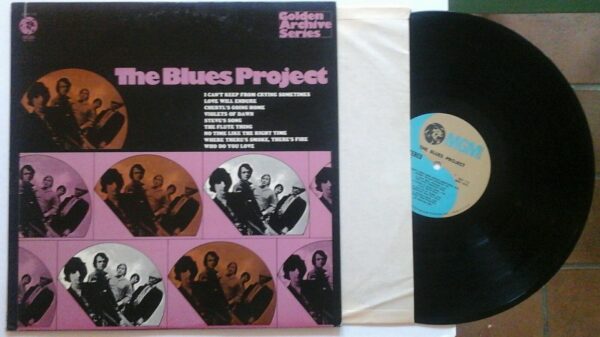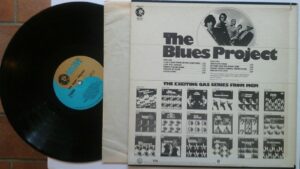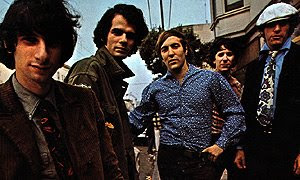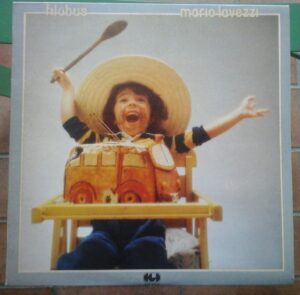Descrizione
PREMESSA: LA SUPERIORITA’ DELLA MUSICA SU VINILE E’ ANCOR OGGI SANCITA, NOTORIA ED EVIDENTE. NON TANTO DA UN PUNTO DI VISTA DI RESA, QUALITA’ E PULIZIA DEL SUONO, TANTOMENO DA QUELLO DEL RIMPIANTO RETROSPETTIVO E NOSTALGICO , MA SOPRATTUTTO DA QUELLO PIU’ PALPABILE ED INOPPUGNABILE DELL’ ESSENZA, DELL’ ANIMA E DELLA SUBLIMAZIONE CREATIVA. IL DISCO IN VINILE HA PULSAZIONE ARTISTICA, PASSIONE ARMONICA E SPLENDORE GRAFICO , E’ PIACEVOLE DA OSSERVARE E DA TENERE IN MANO, RISPLENDE, PROFUMA E VIBRA DI VITA, DI EMOZIONE E DI SENSIBILITA’. E’ TUTTO QUELLO CHE NON E’ E NON POTRA’ MAI ESSERE IL CD, CHE AL CONTRARIO E’ SOLO UN OGGETTO MERAMENTE COMMERCIALE, POVERO, ARIDO, CINICO, STERILE ED ORWELLIANO, UNA DEGENERAZIONE INDUSTRIALE SCHIZOFRENICA E NECROFILA, LA DESOLANTE SOLUZIONE FINALE DELL’ AVIDITA’ DEL MERCATO E DELL’ ARROGANZA DEI DISCOGRAFICI .
THE BLUES PROJECT
golden archive series compilation
Disco LP 33 giri , MGM , Golden Archive Series, GAS 118, 1970 , USA
OTTIME CONDIZIONI, vinyl ex++/NM , cover ex++, piccolo taglio verticale (1 cm.) nell’ angolo superiore sinistro / short promo cut in the high left tip.
The Blues Project was a band from the Greenwich Village neighborhood of New York City
that was formed in 1965 and originally split up in 1967. While their
songs drew from a wide array of musical styles, they are most
remembered as one of the earliest practitioners of psychedelic rock, as well as one of the world’s first jam bands, along with the Grateful Dead.
The Blues Project Golden Archives Series original 9 tracks compilation
Rara compilation americana del 1970 con 9 brani del periodo di furore della band, da non confondersi quindi con l’ incisione eponima del 1972 realizzata dopo la parziale reunion e il radicale rimpasto della line-up
Etichetta: MGM
Catalogo: GAS118
Anno : 1970
Matrici : GAS 118 MGS 2294 / GAS 118 MGS 2295
- Supporto:vinile 33 giri
- Tipo audio: stereo
- Dimensioni: 30 cm.
- Facciate: 2
- Blue-gold label / etichetta blu-oro, white paper inner sleeve
Track listing
Side one
– I Can’t Keep From Crying Sometimes
– Love Will Endure
– Cheryl’s Going Home
– Violets Of Dawn
– Steve’s Song
Side two
– The Flute Thing
– No Time Like The Right Time
– Where There’s Smoke There’s Fire
– Who Do You Love
Personnel
- Danny Kalb – Lead Guitar
- Al Kooper – Organ
- Steve Katz – Rhythm Guitar
- Roy Blumenfeld – Drums
- Andy Kulberg – Bass
- Tommy Flanders – Vocals
In 1964, Elektra Records produced a compilation album of various artists entitled, The Blues Project, which featured several white musicians from the Greenwich Village area who played acoustic blues music in the style of black musicians. One of the featured artists on the album was a young guitarist named Danny Kalb, who was paid $75 for his two songs. Not long after the album’s release, however, Kalb gave up his acoustic guitar for an electric one. The Beatles‘ arrival in the United States earlier in the year signified the end of the folk and acoustic blues movement that had swept the U.S. in the early 1960s. The ensuing British Invasion was the nail in the coffin.
Kalb’s first rock and roll
band was formed in the spring of 1965, playing under various names at
first, until finally settling on the Blues Project moniker as an
allusion to Kalb’s first foray on record. After a brief hiatus in the
summer of 1965 during which Kalb was visiting Europe,
the band reformed in September 1965 and were almost immediately a top
draw in Greenwich Village. By this time, the band included Danny Kalb
on guitar, Steve Katz (having recently departed the Even Dozen Jug Band) also on guitar, Andy Kulberg on bass and flute, Roy Blumenfeld on drums and Tommy Flanders on vocals.
The band’s first big break came only a few weeks later when they auditioned for Columbia Records, and failed. The audition was a success, nevertheless, as it garnered them an organist in session musician Al Kooper. Kooper had begun his career as a session guitarist, but that summer, he began playing organ when he sneaked into the “Like a Rolling Stone” recording session for Bob Dylan‘s album, Highway 61 Revisited. In order to improve his musicianship on the new instrument, Kooper joined the Blues Project and began gigging with them almost immediately. Soon thereafter, the Blues Project gained a recording contract from Verve Records, and began recording their first album live at the Cafe Au Go Go
in Greenwich Village over the course of a week in November 1965. While
the band was known for their lengthy interpretations of blues and
traditional rock and roll songs, their first album saw them rein in
these tendencies because of record label wariness as well as time restrictions.
Entitled Live at The Cafe Au Go Go,
the album was finished with another week of recordings in January 1966.
By that time, Flanders had left the band and, as a result, he appeared
on only a few of the songs on this album.
The album was a moderate success and the band toured the U.S. to promote it. While in San Francisco, California in April 1966, the Blues Project played at the Fillmore Auditorium
to rave reviews. Seemingly New York’s answer to the Grateful Dead, even
members of the Grateful Dead who saw them play were impressed with
their improvisational abilities.(Source: Rock Family Trees – television program)
Returning to New York, the band recorded their second album in the fall of 1966, and it was released in November. Projections contained an eclectic set of songs that ran the gamut from blues, R&B, jazz, psychedelia, and folk-rock.
The centerpiece of the album was an 11-and-a-half minute version of
“Two Trains Running,” which, along with other songs on the album,
showed off their improvisational tendencies. One such song was the
instrumental “Flute Thing”, written by Kooper and featuring Kulberg on
flute.
Soon after the album was completed, though, the band began to fall
apart. Kooper quit the band in the spring of 1967, and the band without
him completed a third album, Live At Town Hall. Despite the
name, only one song was recorded live at Town Hall, while the rest was
made up of live recordings from other venues, or of studio outtakes
with overdubbed applause to feign a live sound. One song in the latter
category, Kooper’s “No Time Like the Right Time,” would be the band’s
only charting single.
The Blues Project’s last hurrah was at the Monterey International Pop Festival held in Monterey, California,
in June 1967. By this time, however, half the original line-up was
gone. Kooper had formed his own band and played at the festival as
well. Katz left soon thereafter, followed by Kalb. A fourth album,
1968’s Planned Obsolescence, featured only Blumenfeld and
Kulberg from the original lineup, but was released under the Blues
Project name at Verve’s insistence. Future recordings by this lineup
would be released under a new band name, Seatrain.
In 1968, Kooper and Katz joined forces to fulfill a desire of Kooper’s to form a rock band with a horn section. The result was Blood, Sweat & Tears. While Kooper led the band on its first album, Child Is Father to the Man, he did not take part in any subsequent releases. Katz, on the other hand, remained with the band into the 1970s.
In the period between 2001-07 or longer, Roy Blumenfeld has been drumming in the Barry Melton Band (Barry of Country Joe & the Fish fame). The band plays in the Northern California area.
The Blues Project, with a modified line-up, reformed briefly in the early 1970s, releasing three further albums: 1971’s Lazarus, 1972’s The Blues Project, and 1973’s The Original Blues Project Reunion In Central Park
(which featured Kooper but not Flanders). These albums did little to
excite the public and since then, the group’s activity has been
confined to a few sporadic reunion concert.
by Richie Unterberger
States, the Blues Project offered an electric brew of rock, blues,
folk, pop, and even some jazz, classical, and psychedelia during their
brief heyday in the mid-’60s.
a blues-rock group, although they did plenty of that kind of material;
they were more like a Jewish-American equivalent to British bands like the Yardbirds,
who used a blues and R&B base to explore any music that interested
them. Erratic songwriting talent and a lack of a truly outstanding
vocalist prevented them from rising to the front line of ’60s bands,
but they recorded plenty of interesting material over the course of
their first three albums, before the departure of their most creative
members took its toll.
in his early twenties a seasoned vet of rock sessions, joined after
sitting in on the band’s Columbia Records audition, although they ended
up signing to Verve, an MGM subsidiary. Early member Artie Traum (guitar) dropped out during early rehearsals; Flanders would leave after their first LP, Live at the Cafe Au-Go-Go (1966).
came from folk, jazz, blues, and rock backgrounds, was reflected in
their choice of material. Blues by Muddy Waters and Chuck Berry tunes ran alongside covers of contemporary folk-rock songs by Eric Anderson and Patrick Sky, as well as the group’s own originals. These were usually penned by Kooper, who had already built songwriting credentials as the co-writer of Gary Lewis’ huge smash “This Diamond Ring,” and established a reputation as a major folk-rock shaker with his contributions to Dylan’s mid-’60s records.
also provided the band’s instrumental highlights with his glowing organ
riffs. The live debut sounds rather tame and derivative; the group
truly hit their stride on Projections
(late 1966), which was, disappointingly, their only full-length studio
recording. While they went through straight blues numbers with
respectable energy, they really shone best on the folk and
jazz-influenced tracks, like “Fly Away,” Katz’s lilting “Steve’s Song,” Kooper’s jazz instrumental “Flute Thing” (an underground radio standard that’s probably their most famous track), and Kooper’s fierce adaptation of an old Blind Willie Johnson number, “I Can’t Keep from Crying.”


A non-LP single from this era, the pop-psychedelic “No Time Like the
Right Time,” was their greatest achievement and one of the best “great
hit singles that never were” of the decade. The band’s very eclecticism
didn’t augur well for their long-term stability, and in 1967 Kooper left in a dispute over musical direction (he has recalled that Kalb opposed his wishes to add a horn section). Then Kalb myseriously disappeared for months after a bad acid trip, which effectively finished the original incarnation of the band.
was a particularly half-assed project given the band’s stature, pasted
together from live tapes and studio outtakes, some of which were
overdubbed with applause to give the impression that they had been
recorded in concert. Kooper got to fulfill his ambitions for soulful horn rock as the leader of the original Blood, Sweat & Tears, although he left that band after their first album; BS&T also included Katz (who stayed onboard for a long time). Blumenfeld and Kulberg kept the Blues Project going for a fourth album before forming Seatrain, and the group re-formed in the early ’70s with various lineups, Kooper rejoining for a live 1973 album, Reunion in Central Park. The first three albums from the Kooper days are the only ones that count, though; the best material from these is on Rhino’s best-of compilation.
Al Kooper, tastierista new-yorkese che aveva suonato gia` con i Royal Teens di
Shorts Shorts (1958), venne reso celebre
dalle incisioni con Dylan del 1965-66.
In quegli anni formo` i Blues Project, un gruppo di folk psichedelico
del Greenwich Village, al fianco di Danny Kalb e Steve Katz
(entrambi chitarristi di provenienza jug).
Il gruppo si conquisto` subito una buona fama negli ambienti
folk del Greenwich Village, registrando dal vivo il primo album
Live At The Cafe` Au Go Go (Verve, may 1966),
ed ebbe subito un piccolo
hit con No Time Like The Right Time
(dodici battute, armonie vocali surf, arrangiamenti esotici).
L’organo di Al Kooper, gli intrecci chitarristici di Katz e Kalb,
il flauto di Andy Kulberg e la batteria jazzata di Roy Blumenfeld
mescolavano con disinvoltura elementi folk, blues e jazz.
Erano figli del folk-rock dei Byrds, ma anticipavano il blues revival di qualche
anno dopo.
Il loro capolavoro fu Projections (Verve, 1967), l’album su cui i
vari elementi meglio si spiegano:
il boogie effervescente di You Can’t Catch Me,
il lamento blues in sordina di Two Trains Running,
il folk strumentale di Steve’s Song,
il pop-jazz raffinato di Flute Thing.
L’apice del disco e del complesso e`
Can’t Keep From Crying, un lambiccato e trascinante
intreccio di riff graffianti, di ritornello orecchiabile, di
distorsioni acute, e di suoni psichedelici.
Si sciolsero nel 1967.
La sezione ritmica (Kulberg e Blumenfeld) si trasformarono nei Seatrain, uno
dei primi complessi di country-rock, il cui primo album,
Planned Obsolescence (Verve, 1968), venne ancora accreditato ai
Blues Project. Vi figurava gia` il violinista prodigio Richard Greene (che aveva
suonato su alcuni dischi di Jim Kweskin), e si
sarebbe aggiunto piu` tardi il chitarrista Peter Rowan, entrambi provenienti
dalla string band di Bill Monroe.
Sul primo album dei Seatrain, Planned Obsolescence (1968),
ancora accreditato al vecchio complesso, svetta
uno strumentale di dodici minuti (Dakota Recollection), e sul successivo
Seatrain (A&M, 1969)
Rowan pennella ballate melodiche assai forbite
che competono
con il piu’ sofisticato rhythm and blues di Kulberg.
Seatrain (Capitol, 1970) e` invece un album piu`
tradizionale (che riprende numeri del bluegrass, soul, rock e pop oltre a
Waiting For Elijah e Song Of Job),
e
la formazione si disintegra dopo Marblehead Messenger (Capitol, 1972).
Rowan e Greene saranno ancora i protagonisti, con
David Grisman e Clarence White,
della celeberrima session di bluegrass progressivo Muleskinner.
Al Kooper e Steve Katz, invece, avevano formato i Blood Sweat & Tears, che volevano
essere un esperimento di “fusion” di generi diversi.
Child Is Father To The Man (Columbia, 1968) fu un album estremamente
ambizioso.
Jim Fielder al basso (ex Buffalo Springfield) completava la parte “rock” del
complesso, ma poi c’erano veterani del jazz come
Dick Hallingan al trombone e
Randy Brecker e Jerry Weiss alle trombe. Soprattutto c’era
Fred Lipsius, che, oltre a suonare il sassofono e il pianoforte, arrangiava
i pezzi con fiati, archi ed effetti sonori. Il materiale purtroppo era debole
(per lo piu` cover).
I Love Her More Than You’ll Ever Know,
My Days Are Numbered e I Can’t Quit Her erano canzoni eleganti
e sofisticate, mentre
Modern Adventures Of Plato, Diogenes And Freud era praticamente musica
da camera per quartetto rock e quartetto jazz.
Kooper venne subito estromesso e Katz ricostitui` la formazione attorno
al cantante David Clayton-Thomas. Ripiegando su un banale rhythm and blues
da classifica, Blood Sweat & Tears (Columbia, 1969) scodello` un hit
dopo l’altro: You’ve Made Me So Very Happy,
Spinning Wheel, And When I Die.
Kooper joined Stephen Stills (the former Buffalo Springfield) and Mike
Bloomfield to record the Super Session (Columbia, 1968) that stands
as a milestone of blues revival (the side with Bloomfield).
His prolific solo career yielded mostly forgettable collections of living-room
rhythm and blues:
I Stand Alone (Columbia, 1969),
You Never Know Who Your Friends Are (Columbia, 1969), that contains
Brand New Day,
the double Easy Does It (Columbia, 1970),
New York City (Columbia, 1971),
A Possible Projection Of The Future (Columbia, 1972),
Naked Songs (Columbia, 1972),
Act Like Nothing Is Wrong (United Artists, 1976),
Championship Wrestling (Columbia, 1982).












